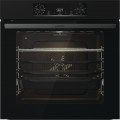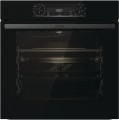Number of modes
The number of cooking modes provided in the design of the oven. In this case, the cooking mode means the general opertaion mode — for example, “heating”, “heating + convection”, etc. Accordingly, this indicator strongly depends on additional equipment (see "Features"). However, even in similar models, the number of modes may be different. In general, the
more cooking modes, the more cooking options, the easier it will be to choose the optimal mode for a specific situation.
Features
Among the ovens features, one can single out the basic ones inherent in most devices (
gas control,
auto ignition,
thermostat, timer,
auto switch-off,
child lock), and top-level features that are relevant for devices of the highest category (
control via Internet,
built-in video camera,
TFT display). More about them:
— Gas control. Thermoelectric system designed to protect against gas leakage. If the flame is accidentally extinguished, the gas supply to the chamber is immediately stopped. The gas control usually includes a thermocouple (to determine the presence or absence of a flame) and a gas blocking device.
— Auto ignition. A system that provides automatic ignition of gas simultaneously with the start of its supply. The user does not need to use matches or a lighter, press a separate button, etc.: the gas ignites immediately when the handle is turned. Found only in models with appropriate heaters (see "Oven").
— Thermostat. A device that maintains a predetermined temperature in the oven.
— Timer. A device that provides a countdown time and allows you to control the cooking process precisely. After the set time has elapsed, the timer, usually, beeps, and in some models, i
...t also turns off the heating. Timers can be either mechanical or electronic; the first one is simple and inexpensive, and the second one is more accurate and better combined with additional features (for example, auto switch-off).
— Auto switch-off. In this case, we are talking about a function that provides automatic shutdown of the oven according to the timer (see below); the timer itself does not imply auto-off, so if such an ability is important, you should choose a model where it is directly stated. Also, auto switch-off can be provided as a protective system that prevents overheating — such automation turns off the oven if no commands have been received from the user for a long time or when the temperature rises critically.
— Control via Internet. The specific control method may be different: some models use an application that needs to be installed on a smartphone or tablet, while others use a regular web page that can be opened in any browser. These details should be specified separately. Anyway, this function allows you to access control from anywhere in the world where there is access to the World Wide Web. For example, in the morning you can load food for a dish into the oven, and when you leave work, launch a cooking programme via the Internet, and get a ready-made hot dish by the time you return home. Also, note that such control usually allows not only to give commands but also to receive notifications from the oven. In particular, the device can report the progress of the programme, readiness, various problems, etc.
— Video camera. The presence of a built-in camera for more detailed control of the preparation of the dish. The user can visually control the cooking process without opening the oven door. Most often, the built-in camera transmits video via a wireless Wi-Fi connection. As a pairing device, you can use both a computer with a laptop and a tablet/smartphone. Of course, on a mobile/computer device, you will need to install proprietary software. The video camera is especially relevant in cases where the oven is used to prepare complicated meals. Regular control, without disturbing the temperature regime due to the opening of the door, minimizes the risk of food spoilage.
— TFT display. The oven has its TFT display. In this case, we mean a screen that does not consist of segments but pixels and is suitable for displaying various types of data: numbers, text, graphic symbols, pictures, etc. A wide variety of information can be displayed on the TFT display, which makes the operation of the oven more convenient. However, this variety is only relevant for advanced models with an abundance of functions, so the presence of such a screen is usually a sign of a premium oven.
— Child lock. In modern ovens, it can be done in different ways. So, in some models, you can block the oven door — so that a curious little child cannot open it during cooking and get burned. In other devices, a control panel lock is also provided — thanks to it, the baby will not be able to turn on/off the device or change the cooking mode. Child lock is unlocked in a non-obvious way accessible to an adult but not to a child — for example, by simultaneously pressing two buttons.Number of door glasses
The number of layers of glass in the viewing window of the oven door.
Modern models, usually, have from 2 to 4 glasses. The
more glasses, the less heat loss and the more economical the oven, but this parameter also affects the cost.
Door closer
The presence of an
automatic door closer in the design of the oven.
Such a device is responsible for pulling the door when closing, and in some models, when opening. The idea is that the user does not need to close/open the door completely — just pull it to the right place, and then the door will be smoothly brought to a fully open or closed state by the door closer. Such a system performs two functions. Firstly, it reduces to almost zero the risk of leaving the oven not completely closed (which is fraught with various unpleasant situations): the auto-closer is usually able to attract even a fairly wide open door. Secondly, such a device provides a very smooth opening and closing, without shock, which has a positive effect on the service life of the entire oven.
Guides
Type of guides for installing baking sheets that are used in the oven.
—
Frame. Classic guides have the form of slots with protrusions in the side walls of the oven. This design is simple and inexpensive. However, it is not very convenient — when removing baking sheets, you have to pull your hand into a heated oven, which means you will need a mitten or potholder. And the extraction itself may require effort, especially if the guides are dirty and the trays go tight in them.
—
Telescopic. Retractable guides on which the baking sheet “leaves” the oven, usually, immediately when the door is opened. Such devices are more convenient than frame ones, but they are more expensive and not suitable for all situations (for example, sometimes to check a dish you only need to open the lid without pulling it out). Therefore, in most models,
telescopic guides are only on one level. But
telescopic guides on two levels or even
three levels already classifies the device as a top segment.
Oven cleaning
The type of inner cleaning provided in the oven. Note that pollution has to be removed with a rag or sponge, but modern ovens often provide various tricks that facilitate the process. The options might be:
—
Catalytic. A special wall coating is used in ovens with this cleaning method: it breaks down fats and other stubborn dirt into constituent elements that can be easily removed. The effectiveness of such a coating decreases over time, but it is enough for at least several years of full use. It should be noted that the catalytic coating can be implemented by applying it to special removable plates that are installed on the back or side walls of the oven chamber.
—
Steam cleaning. Cleaning with hot steam, which softens dried-on dirt and partially breaks down fats. In some models, there is a built-in steam generator for this, in others it is enough to put a container of water in the working chamber and turn on the cleaning program.
—
Pyrolytic. Cleaning by heating the chamber to a very high temperature — about 500 ° C. At this temperature, most of the contaminants are incinerated into ash, which can then be easily removed. Pyrolytic cleaning is considered the most effective, but ovens with this function are expensive, time consuming, require significant electricity/gas consumption, and can lead to unpleasant odors.
Energy class
This indicator characterizes how economically the oven consumes electricity. Initially, classes were marked in Latin letters from
A(highest) and further down as they went down. Later improved classes
A +,
A ++, etc. appeared (the more pluses, the better). More energy-efficient models are more expensive but can pay for themselves in the process of use, especially if you have to cook often and in large quantities.

